Orders of Magnitude
Before we look at the structure of the atom in greater detail we should consider the relative size of objects in the universe. This includes sub atomic particles with a size as small as 10-15 m to the total size of the universe, 1029 m.
This is a vast range of sizes and so physicists use the concept of order of magnitude to help organise the objects. The order of magnitude gives an idea of the approximate number of digits in the number being used. Consider an adult human, average height 1.75 m, has an order of magnitude equivalent to 100 m. This means that to the closest approximation 1 m, not 101 = 10 m.
The distance from south Aberdeen to Dundee is 100 km, which is 100,000 m or 105 m. We say that this is 5 orders of magnitude in size. We could also comment on the relative sizes of a human and this distance. The distance to Dundee is 5 orders of magnitude greater than the size of an adult human
A great site to look at the order of magnitude of objects is at:
Perimeter Institute Orders of 10Another great site is:
Florida State University Orders of 10How many orders of magnitude greater is the radius of the Earth's orbit around the sun and the radius of the earth?
Orbital radius = 150 million km = 150,000,000,000 m
Radius of the Earth = 6380 km = 6380,000 m
Earth is approximately = 107 m and the radius is approximtely 1011 m.
Therefore the radius is 4 orders of magnitude greater (11 - 7).
The standard model
In National 5 physics you learned about the structure of atoms, and that they had a nucleus with protons and neutrons present, with electrons in shells orbiting the nucleus. This is called the Bohr model of the atom.
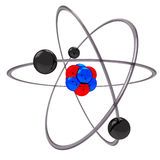
When protons, neutrons and electrons are crashed into each other at very high speeds (close to the speed of light) in particle accelerators both the protons and neutrons break apart. The electron has not broken into anything smaller. Physicists call particles that cannot break apart any further fundamental particles.
Both protons and neutrons can be broken into smaller particles so they are not fundamental particles. The electron is a fundamental particle because it has not yet been broken into anything smaller.
When physicists began to research in this area of physics many new particles were found. The vast number of particles and their associated properties gave rise to a very complex picture that was called the particle zoo.
Although the picture was very complicated Murray Gell-Mann propsed a model to simplify the data that had been discovered. He introduced the concept of quarks in 1961, and was awarded the Nobel prize in 1969 for his work on fundamental particles. He proposed a system with families of particles and the property of strangeness which we still use today.
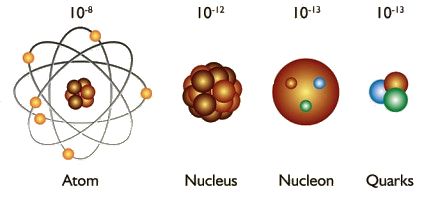
| 1st Generation | 2nd Generation | 3rd Generation | ||
|---|---|---|---|---|
| Quark | Name Charge Spin | Up +2/3 ½ | Charm +2/3 ½ | Top +2/3 ½ |
| Name Charge Spin | Down -1/3 ½ | Strange -1/3 ½ | Bottom -1/3 ½ |
|
| Lepton | Name Charge Spin | Electron -1 ½ | Muon -1 ½ | Tau -1 ½ |
| Name Charge Spin | Electron Neutrino 0 ½ | Muon Neutrino 0 ½ | Tau Neutrino 0 ½ |
Remember that the first generation particles are ones that are found widely throughout the universe.
Second and third generation particles are found in high energy particle accelerators and other high energy processes in the universe. They form short lived particles that are not stable. The lifetimes of these particles can be as large as microseconds to smaller than femtoseconds.
Antimatter
In 1929 Dmitri Skobeltsyn was investigating gamma cosmic rays with a cloud chamber. He discovered a particle that behaved like an electron, but with the opposite charge. The curvature of its path in a magnetic field was opposite to that of an electron. It appeared in the same place and at the same time as the electron. What he had discovered was the first experimental evidence for antimatter. The particle was called a positron which is the antimatter particle of the electron.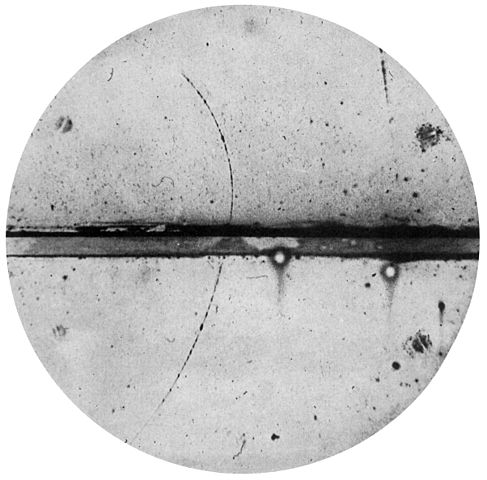
Source: By Carl D. Anderson (1905-1991) - Anderson, Carl D. (1933).
Since then, scientists have discovered that all matter particles have a corresponding antimatter particle. Where the matter particle has a charge, it's antimatter particle will have the opposite charge.
Matter and antimatter pairs can be made using high energy gamma rays or high energy collisions in particle accelerators.
When an antimatter particle meets its corresponding matter particle both are destroyed. They form two gamma photons containing the energy that was contained in the particles according to E = mc2. This is called a particle-antiparticle annihilation. Two photons are created because momentum must be conserved from the collision of the two particles.
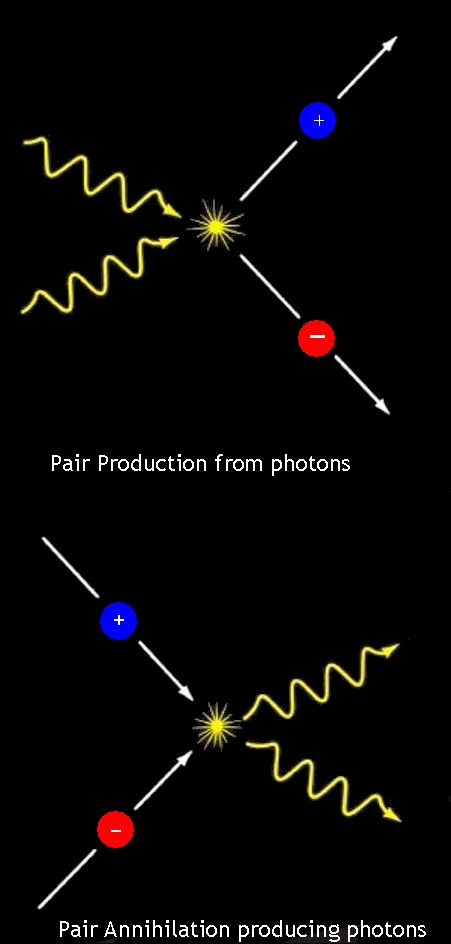
Beta Emission
In National 5 physics you were introduced to radioactivity and beta particles. In higher this is extended to understand that the emission of a beta particle also involves another, even smaller particle.
When investigating the energies of beta emission from bismuth-210 it was found that the beta particles were emitted with a range of energies. This caused a problem for physicists. Where did the unaccounted for energy go? Was beta emission a process that broke the fundamental rules of energy conservation and momentum conservation? Why were not all of the beta particles emitted with the maximum kinetic energy?
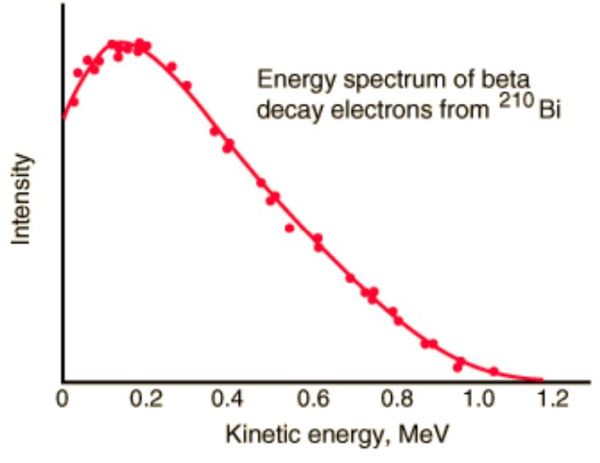
From G. J. Neary, Proc. Phys. Soc. (London), A175, 71 (1940).
The Neutrino
Too many of the fundamental laws of physics woud be broken so in 1930 Wolfgang Pauli proposed a new particle in a letter to scientists debating the issue in Tübingen. The new particle had spin ½, no charge, a mass no greater than the electron, and would resolve the issues with energy and momentum. The only problem with the idea was that this particle had not been discovered. As a tiny neutral particle it would be very diffcult to discover. Remember, this was at a time before the experimental evidence for the existence of the neutron (a much more massive particle) was discovered! It took another 26 years to find experimental evidence for the existence of the neutrino. Reines and Cowan - 1956 experimentally demonstrated the existence of neutrinos.
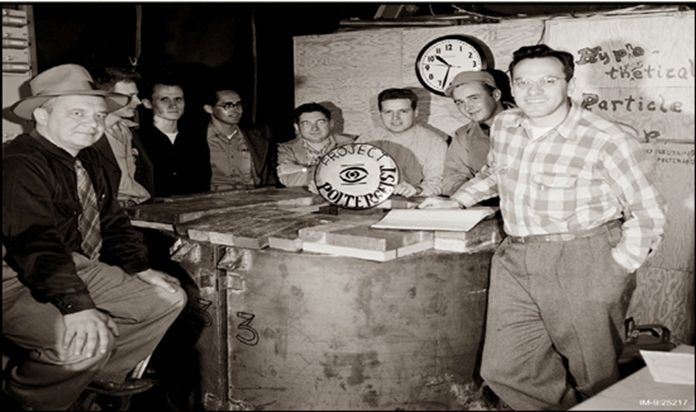
In fact during beta minus emission it is an antineutrino that is generated. In beta plus emission a neutrino is produced.
Beta Minus (β−) Equation
Notice the bar above the neutrino in the equation. This indicates that it is an antimatter particle, the antineutrino.
Richard Feynman came up with a way of representing particle interactions. This is not part of the syllabus, but is included here for interest. The Feynamn diagram for the above process involving the formation of a β particle is shown below:
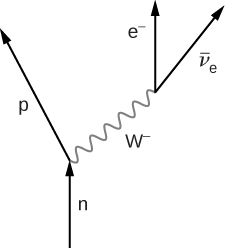
Fermions
Fermions are the sub atomic particles that make up all matter particles. They include the quarks and the leptons. Fermions are sub divided into baryons composed of three quarks, mesons composed of a quark-antiquark pair and leptons.
| 1st Generation | 2nd Generation | 3rd Generation | ||
|---|---|---|---|---|
| Quark | Name Charge | Up +2/3 | Charm +2/3 | Top +2/3 |
| Name Charge | Down -1/3 | Strange -1/3 | Bottom -1/3 |
|
| Lepton | Name Charge | Electron -1 | Muon -1 | Tau -1 |
| Name Charge | Electron Neutrino 0 | Muon Neutrino 0 | Tau Neutrino 0 |
Baryons
ProtonThe most stable baryon is the proton. It is composed of two up quarks and a down quark (uud).
The charge on a proton is +1, let us see how adding the quark charges results in this answer.
Up quark charge is +2/3, down quark charge is −1/3
u + u + d = +2/3 +2/3 −1/3 = +1
The next baryon we can consider is the neutron. It is composed of one up quark and two down quarks (udd).
The charge on a neutron is 0, let us see how adding the quark charges results in this answer.
Up quark charge is +2/3, down quark charge is −1/3
u + d + d = +2/3 −1/3 −1/3 = 0
Baryons have spin values in the 1/2 integer range and so are governed by the Pauli exclusion principle. Baryons are classed as Fermions.
Mesons
A pion+ (Π+) is a meson composed of an up and an antidown quark-antiquark pair.
Up quark charge is +2/3, antidown quark charge is +1/3
u + d bar = +2/3 + +1/3 = +1
Mesons have integer values of 'spin' and are not governed by the Pauli exclusion principle. Mesons are classed as Bosons.
Guage Bosons
Guage Bosons are the force mediating particles that are involved in the four fundamental forces| Photon | Gluon | W± and Z0 | Graviton | |
|---|---|---|---|---|
| Force | Electromagnetic | Strong Nuclear | Weak Nuclear | Gravitation |
| Range | Infinite | 10−15 m | 10−18 m | Infinite |
| Relative Strength | 1036 | 1038 | 1025 | 1 |